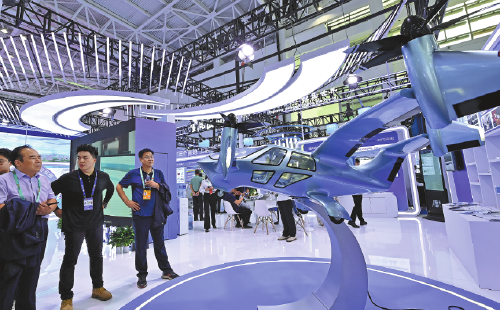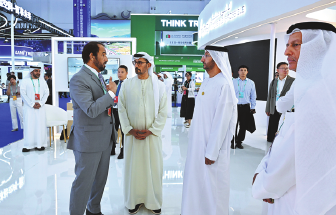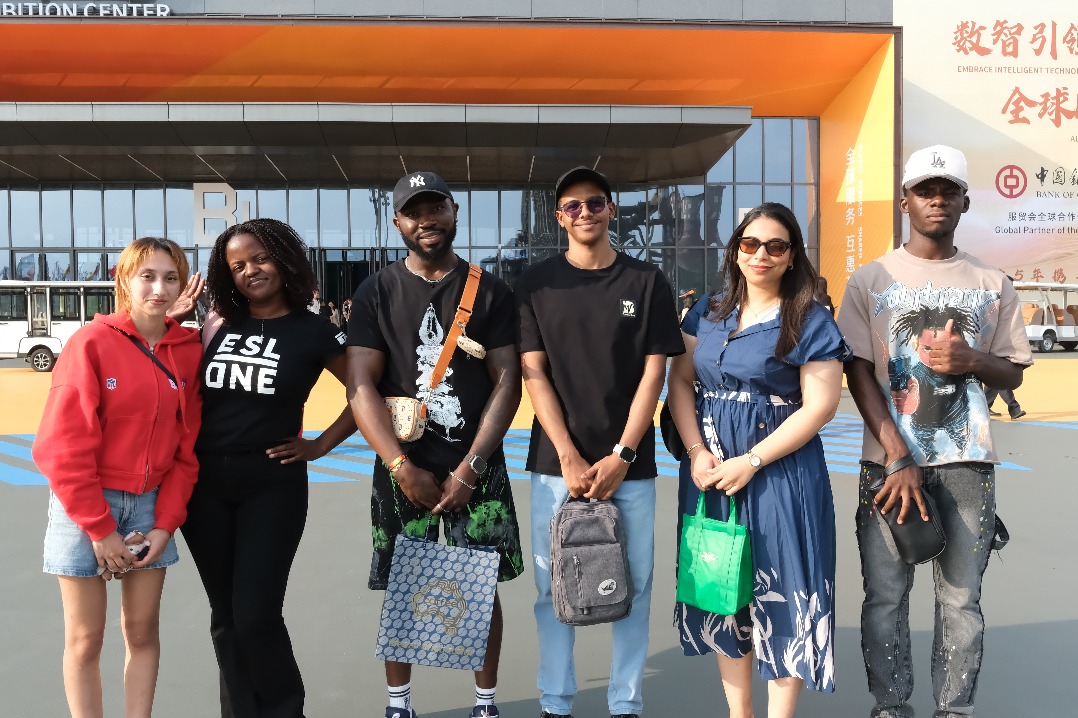Sino-Arabian ties focus on novel frontiers
Nation's tech, manufacturing prowess and Arab world's thrust on diversification creating new growth engines, experts say


As China and the Arab world strengthen economic ties in traditional industries, their collaboration's promise lies in the vast, untapped potential of emerging and high-tech domains, from green energy to artificial intelligence, analysts and industry executives said.
China's technological prowess and manufacturing capabilities and the Arab nations' focus on economic diversification and modernization create a fertile ground for fostering new growth engines that will benefit both sides, they added.
At the recently concluded China-Arab States Expo in Yinchuan, Ningxia Hui autonomous region, an agricultural system exhibit commanded attention not through flashy presentation, but through sheer innovation of green and efficient food production, even in the arid Arab nations.
The centerpiece, from Ningxia Ziranke Ecological Environment Co, is a colossal containerized plant factory — a 12.2-meter-long, 2.5-meter-wide, 2.9-meter-high and 8.8-metric-ton behemoth.
Engineered with direct green power connectivity, it can plug directly into photovoltaic solar or wind power sources, ensuring stable energy supply for the entire agricultural process, said Ma Jintao, project manager of the company.
"It's decoupled from the external environment, thanks to its hydroponic control system and automated climate management," Ma said. "By eliminating the need for traditional farmland, this solution can be deployed virtually anywhere, from deserts to tundras."
The unit yield of this system can be several times higher than conventional farming methods, while using over 95 percent less water and virtually no pesticides, Ma said, adding that this unlocks new pathways for food production in the Arab world where there is sufficient green energy but a lack of water resources.
"We receive less than 100 millimeters of rainfall annually and have no natural rivers, with 90 percent of our water supply relying on seawater desalination and groundwater," said Alraddadi Jamal Salem M, CEO of Alraddadi Trading Co.
This Chinese high-tech solution meets Saudi Arabia's needs from multiple dimensions, including climate adaptation, environmental compatibility and resource efficiency. It solves the pain points of traditional agricultural cultivation and has the potential for large-scale deployment, he said.
The sustainable agricultural solution for arid regions is truly a shining example of China-Arab States cooperation. China is helping transform the Arab world in a myriad ways — a consensus which emerged from the four-day biennial expo in late August.
This year's expo, the seventh edition of its kind, has seen participation from all 22 Arab nations for the first time.
In 2024, trade volume between China and Arab countries reached $407.4 billion, marking a 2.3 percent year-on-year increase and securing China's status as the Arab world's largest trading partner, data from the Ministry of Commerce showed.
Chinese exports to the region totaled $206 billion, while imports from Arab nations were $201.4 billion, demonstrating continued growth and mutual benefit in their economic and trade relations, according to the data.
In addition, China has signed Belt and Road cooperation documents with all the 22 Arab countries and the League of Arab States, under which more than 200 major projects have been implemented.
"The Arab countries are at a pivotal moment in their development, and China's expertise and resources make it an indispensable ally in this process," said Khaled Hanafi, secretary-general of the Union of Arab Chambers.
The two sides could strengthen their collaboration in priority areas such as the low-altitude economy, new energy, smart logistics and advanced manufacturing, charting new paths for mutually beneficial cooperation, Hanafi said.
In the vast, sunbaked landscapes of the Arab world, a new and unexpected sound is becoming more common: the quiet whir of unmanned aerial vehicles. This is the sound of a nascent but rapidly expanding frontier in China-Arab cooperation — the low-altitude economy.
With vast expanses of territory, relatively sparse populations and dispersed urban and rural settlements interspersed with vast desert landscapes, the Arab nations have provided an ideal testing ground and application scenario for China's burgeoning unmanned aerial vehicle industry, said Zhao Xudong, vice-president of the Ningxia Low-Altitude Economy Industry Association.
From oilfield inspections and photovoltaic panel cleaning to agricultural irrigation and large-scale performances to attract tourists — each of these solutions directly addresses the real-world demands of the Arab world, Zhao said.
This confluence of China's advanced experience in low-altitude economy technology research, manufacturing and operational management, coupled with the unique geographic environment and market demands of the Arab world, has laid the foundation for collaboration, Zhao added.
During the expo, the China-Arab States Technology Transfer Center unveiled a comprehensive portfolio of over 500 advanced and practical technology solutions tailored to the urgent needs of Arab nations in areas ranging from green agriculture and digital economy to industrial upgrade and ecological protection.
"Our goal is to ensure that every technology solution we offer is directly aligned with market demand and development priorities of the Arab world," said Wu Lifeng, director of the center.
The selection process involved screening of over 1,300 technologies from more than 60 leading Chinese universities, research institutes and enterprises, with a focus on solutions that can be rapidly scaled up across the Arab world, Wu added.
"On the very day of the technology release, we managed to sign 13 cooperation agreements, underscoring the strong demand and willingness of our Arab partners to adopt these cutting-edge solutions," Wu said.
In particular, green and low-carbon technology solutions have become veritable buzzwords at the expo. While the two regions may differ in their resource endowments, they are united in their drive toward a shared goal of clean, green and low-carbon progress.
The Arab region is home to some of the world's best solar and wind energy resources, providing an unparalleled opportunity for the development of clean energy, said Zhou Mi, a senior researcher at the Chinese Academy of International Trade and Economic Cooperation.
Concurrently, Arab nations, particularly those in the Gulf, are vigorously pursuing ambitious national visions — such as Saudi Arabia's Vision 2030 and the United Arab Emirates' Centennial 2071 — which prioritize sustainable development and a transition away from hydrocarbon dependency.
At the same time, China has amassed a wealth of experience in renewable energy technology research and development, industrial application and project implementation — expertise that can be leveraged to complement the Arab world's natural advantages, Zhou added.
Over the past decade, China has played a pivotal role in driving down the average cost of electricity generation from wind and solar photovoltaic projects globally by 60 percent and 80 percent, respectively, data from the National Energy Administration showed in late August.
During the 14th Five-Year Plan period (2021-25), the country's exports of wind and solar PV products are estimated to have cumulatively reduced carbon emissions in other nations by around 4.1 billion tons, making a significant contribution to the global low-carbon transition, the administration said.
Ahmed Mustafa Fahmy, head of the League of Arab States' China Representative Office, said that China's mature technological capabilities are meeting the ambitious policy vision and significant market potential of the Arab world. This combination is proving to be a recipe for success in high-tech collaboration.
At a moment of heightened global economic fragility, the deepening partnership between China and Arab nations stands out not merely as a bilateral success story, but as a potential source of stability and growth for the wider world, he said.


Today's Top News
- Madrid talks show negotiations remain the best way forward: Editorial flash
- China, US reach basic consensus on TikTok
- Nation's growth steady amid headwinds
- Establishment of nature reserve beyond criticism, aligns with regional interests
- Engulfing Middle East in war serves no party
- Xi's article on building unified national market to be published






























